
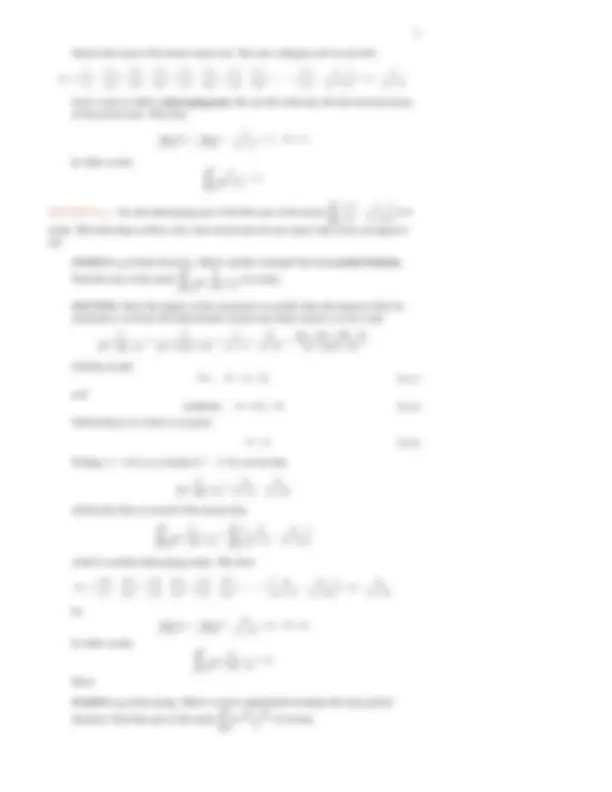

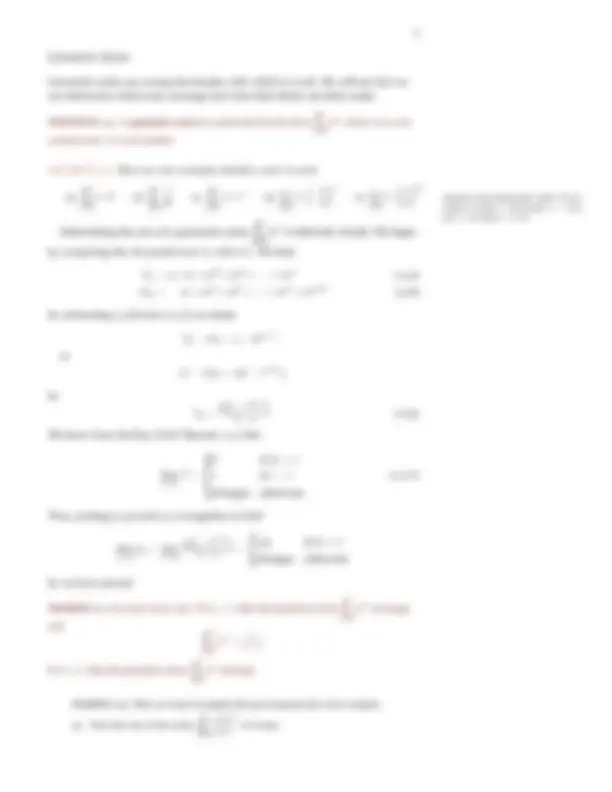
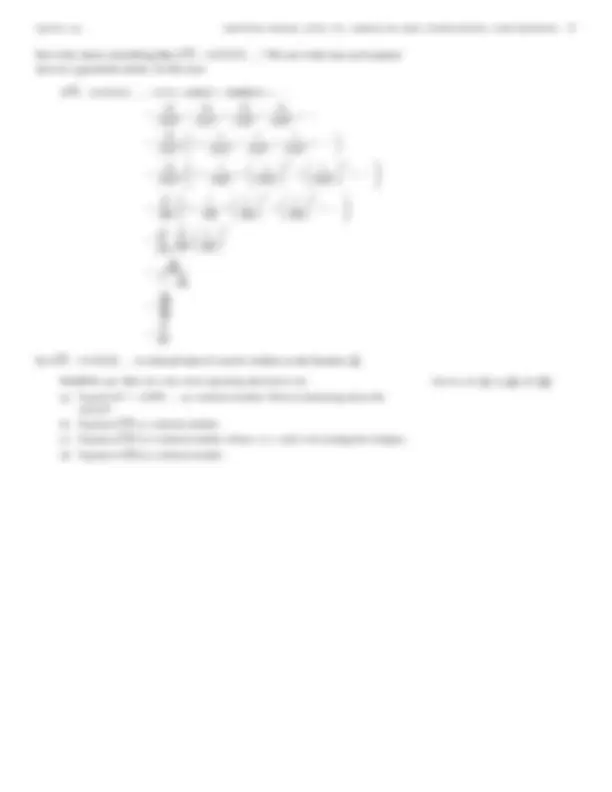
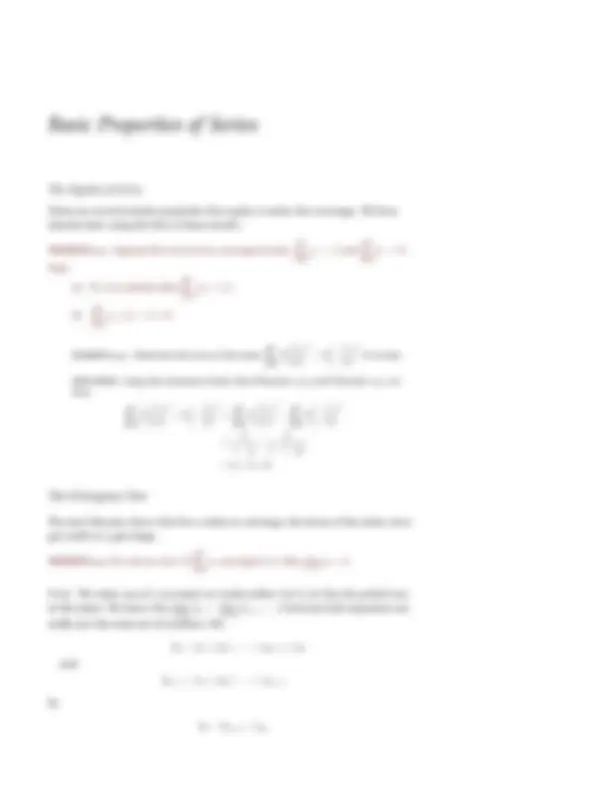
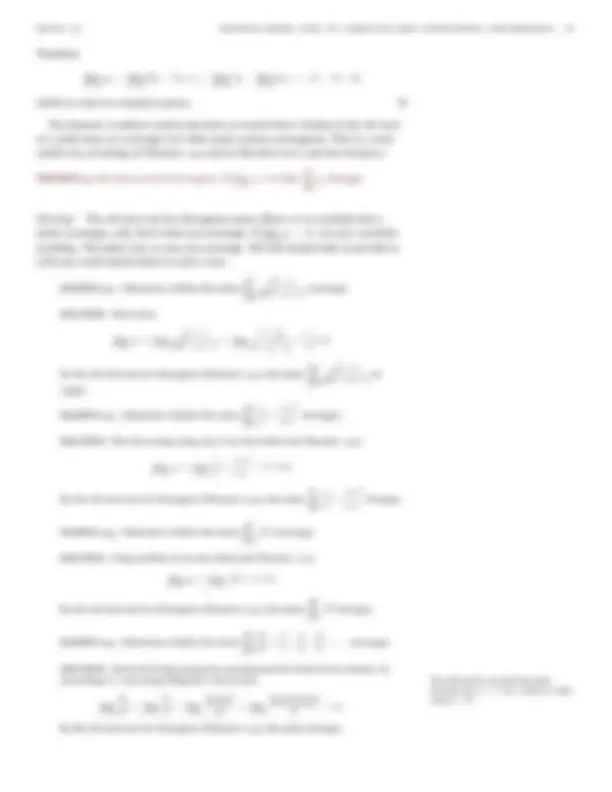


Study with the several resources on Docsity

Earn points by helping other students or get them with a premium plan


Prepare for your exams
Study with the several resources on Docsity

Earn points to download
Earn points by helping other students or get them with a premium plan
Community
Ask the community for help and clear up your study doubts
Discover the best universities in your country according to Docsity users
Free resources
Download our free guides on studying techniques, anxiety management strategies, and thesis advice from Docsity tutors
Various concepts related to infinite series, including the process of forming infinite sums, the concept of partial sums, and the limit of a series. It covers different types of series such as geometric series and telescoping series, and provides methods for determining the sum of a series if it exists. The document also discusses the basic properties of series and the algebra of series.
Typology: Study notes
1 / 11

This page cannot be seen from the preview
Don't miss anything!







Introduction to Series
k = 1
k = 1
k = 1
n = 0
n = 0
DEFINITION 13. 1. To find the sum of an infinite series (^) Â • k = 1 a (^) k we form the sequence of partial sums that are often denoted by S (^) n.
S 1 = a (^1) S 2 = a 1 + a (^2) S 3 = a 1 + a 2 + a (^3) .. .
S (^) n = a 1 + a 2 + a 3 + · · · + a (^) n =
n  k = 1
a (^) k ( S (^) n is called the n th partial sum of the series )
If the sequence of partial sums (^) { S (^) n } • n = 1 has a limit a limit L (converges), we say that the series converges to L and we write:
 k = 1
a (^) k = (^) nlim! •
n  k = 1
a (^) k = (^) nlim! • S (^) n = L
or just
 k = 1
a (^) k = L.
Otherwise the series diverges.
EXAMPLE 13. 1. Here’s a simple example. Find the sum of the series
 k = 1
2 k^
if it exists.
SOLUTION. We first determine each partial sum and then rewrite it in a more conve- nient form.
S 1 =
S (^) n =
2 n^
2 n
So the sequence of partial sums is { S (^) n } • n = 1 =
n 1 � (^21) n
o (^) • n = 1 and
nlim! • S^ n^ =^ nlim! • 1 �^
2 n^
where we have used Theorem 13. 2 to evaluate the limit. In other words,
 k = 1
2 k^
Pretty cool!
EXAMPLE 13. 2. Here’s a another fun example. Find the sum of the series
 k = 1
k 2 + k if it exists.
SOLUTION. Using partial fractions (check this)
 k = 1
k 2 + k
 k = 1
k
k + 1
SOLUTION. We can use a log property to rewrite the partial sum as
S (^) n =
n  k = 1
ln
k + 1 k
n  k = 1
ln ( k + 1 ) � ln k
= ( ln 2 � ln 1 ) + ( ln 3 � ln 2 ) + ( ln 4 � ln 3 ) + · · · + [ ln ( n + 1 ) � ln n ] = ln n � ln 1.
Therefore nlim! • S^ n^ =^ nlim! • ln^ n^ �^ ln 1^ =^ •^ (diverges) and the series (^) • Â k = 1
ln
k + 1 k
diverges.
EXAMPLE 13. 5 (Partial Fractions). Here’s a more complicated example that uses partial fractions. Find the sum of the series
 k = 0
k 2 + 4 k + 3 if it exists.
SOLUTION. Since the degree of the numerator is smaller than the degree of the de- nominator a nd since the denominator factors into linear factors, we can write 8 k 2 + 4 k + 3
( k + 1 )( k + 3 )
k + 1
k + 3
Ak + 3 A + Bk + B ( k + 1 )( k + 3 )
Solving we get: k’s : 0 = A + B. ( 13. 4 ) and constants : 8 = 3 A + B. ( 13. 5 ) Subtracting ( 13. 4 ) from ( 13. 5 ) gives 8 = 2 A. ( 13. 6 )
Putting A = 4 in ( 13. 4 ) makes B = � 4. So we see that 8 k 2 + 4 k + 3
k + 1
k + 3
This means that (^) • Â k = 0
k 2 + 4 k + 3
 k = 0
k + 1
k + 3
which is another telescoping series.
S (^) n =
4 1 �^ 4 3
4 2 �^ 4 4
4 3 �^ 4 5
4 4 �^ 4 5
4 n � 1 �^ 4 n + 1
4 n �^ 4 n + 2
4 n + 1 �^ 4 n + 3
S (^) n = 4 + 2 � (^) n +^4 2 � (^) n +^4 .
So lim n! • S (^) n = lim n! •
n + 2
n + 3
In other words,
 k = 0
k 2 + 4 k + 3
YOU TRY IT 13. 2 (Partial fractions). Here are two others that are similar to the last example in that they use partial fractions. See if you can solve them. Find the sums of these series if they exist.
(a)
 k = 0
k 2 + 7 k + 12
(b)
 k = 0
k 2 + 4 k + 3 Answers: (a) 14 ; (b) 32.
Geometric Series
DEFINITION 13. 2. A geometric series is a series that has the form
 n = 0
ar n^ , where a is a real
constant and r is a real number.
YOU TRY IT 13. 3. Here are a few examples. Identify a and r in each.
(a)
 n = 0
6 · 4 n^ (b)
 n = 0
2 n^ (c)
 n = 0
2 · 3 �^ n^ (d) (^) Â n = 2
◆ (^) n (e) (^) Â n = 1
◆ (^2) n Answers: (a) 6 and 4; (b) 1 and 1/2; (c) 2 and 1/3; (d) a = 20/9 and r = � 2/3; (e) a = 2/9 and r = 1/9.
 n = 0
n! •
n! •
n! •
a
THEOREM 13. 1 (Geometric Series Test). If | r | < 1, then the geometric series
 n = 0
ar n^ converges
and (^) •
 n = 0
ar n^ = a 1 � r
If | r | � 1, then the geometric series
 n = 0
ar n^ diverges.
EXAMPLE 13. 6. Here are some examples that get progressively more complex.
(a) Find the sum of the series
 n = 0
◆ (^) n if it exists.
EXAMPLE 13. 7. Here are a two more examples.
(a) Find the sum of the series
 n = 3
◆ (^) n if it exists.
SOLUTION. First rewrite the series adding back and then subtracting the first few ‘missing’ terms.
 n = 3
 n = 0
◆ (^) n! �
By Theorem 13. 1 the series converges to (^1) �^1 3
Alternative Method. Write out the first few terms of the series and identify a and r. (^) • Â n = 3
|{z}^27 a
|{z}^81 ar
|{z}^243 ar 2
|{z}^729 ar 3
Now a = 278 and the ratio of a term to the previous one is r = 23 and | r | < 1. So by Theorem 13. 1 the series converges to 278 1 �( 23 ) =^
8
(b) Find the sum of the series
 n = 2
◆ (^) n if it exists.
SOLUTION. First rewrite the series; be careful of the signs.
 n = 2
 n = 0
◆ (^) n! �
By Theorem 13. 1 the series converges to (^1) �(^4 � 1 3 )^
Alternative Method. Write out the first few terms of the series and identify a and r. (^) • Â n = 2
|{z}^9 a
|{z}^27 ar
|{z}^81 ar 2
|{z}^243 ar 3
Now a = 49 and the ratio of a term to the previous one is r = 13 and | r | < 1. So by Theorem 13. 1 the series converges to
(^49) 1 �(� 13 ) =^
1
(Optional) Application: Repeating Decimals
indicate which part of the decimal
 n = 0
12 100
12 100 99 100
EXAMPLE 13. 8. Here are a few more repeating decimals to try. Answers: (b) 123999 ; (c) 9999 abcd ; (d) 12229900. (a) Express 0.9 = 0.9999... as a rational number. What is interesting about the answer? (b) Express 0.123 as a rational number. (c) Express 0.abcd as a rational number, where a, b, c, and d are nonnegative integers. (d) Express 0.1234 as a rational number.
n! •
n! •
n! •
n! •
THEOREM 14. 3 (The nth term test for divergence). If lim n! • a (^) n 6 = 0, then
 n = 0
a (^) n diverges.
n! •
EXAMPLE 14. 2. Determine whether the series
 n = 0
n 2 + 1 3 n 2 + n + 1 converges.
SOLUTION. Notice that
nlim! • a^ n^ =^ nlim! •
n 2 + 1 3 n 2 + n + 1 = (^) nlim! •
1 + (^) n^1 3 + (^1) n + (^1) n
By the nth term test for divergence (Theorem 14. 3 ), the series
 n = 0
n 2 + 1 3 n 2 + n + 1 di- verges.
EXAMPLE 14. 3. Determine whether the series
 n = 1
k n
◆ (^) n converges.
SOLUTION. This time using using one of our key limits (see Theorem 13. 2 )
nlim! • a^ n^ =^ nlim! •
k n
◆ (^) n = e k^6 = 0.
By the nth term test for divergence (Theorem 14. 3 ), the series
 n = 1
k n
◆ (^) n diverges.
EXAMPLE 14. 4. Determine whether the series
 n = 1
p n (^) n converges.
SOLUTION. Using another of our key limits (see Theorem 13. 2 )
nlim! • a^ n^ =^ nlim! •^ n
p n = 1 6 = 0.
By the nth term test for divergence (Theorem 14. 3 ), the series
 n = 1
p n (^) n diverges.
EXAMPLE 14. 5. Determine whether the series
 k = 1
2 n n 2
SOLUTION. Notice that both numerator and denominator both tend to infinity. So converting to x and using l’Hôpital’s rule (twice!) We will need to use the derivative formula (^) dxd ( a x^ ) = a x^ ln a, which is valid when a > 0. nlim! •
2 n n 2 = (^) xlim! •
2 x x 2 = (^) xlim! •
( ln 2 ) 2 x 2 x = (^) xlim! •
( ln 2 )( ln 2 ) 2 x 2
By the nth term test for divergence (Theorem 14. 3 ), the series diverges.
EXAMPLE 14. 6. Determine whether the series
 k = 1
n and
 k = 1
n 2
converge.
SOLUTION. Notice that both lim n! •
n
and lim n! •
n 2
In this situation the nth term test for divergence (Theorem 14. 3 ) fails to provide us with any information. The series may or may not converge. In fact, we will soon see that one of these series converges while the other diverges.
EXAMPLE 14. 7. Determine whether the series
 k = 1
cos (^1) n converges.
SOLUTION. Notice that
nlim! • cos^1 n^ =^ cos 0^ =^1 6 =^ 0. By the nth term test for divergence (Theorem 14. 3 ) the series diverges.
YOU TRY IT 14. 4. Here are six series. Which of them can you say diverge by the nth term test for divergence? For which series is this test not helpful. Explain.
(a)
 n = 1
3 n + 1 2 n + 5 (b)
 n = 1
n 2 n 2 + 1 (c)
 n = 1
( 1.1 ) n
(d)
 n = 1
n
◆ (^) n (e)
 n = 1
p n (^) n (f )
 n = 1
n! n n